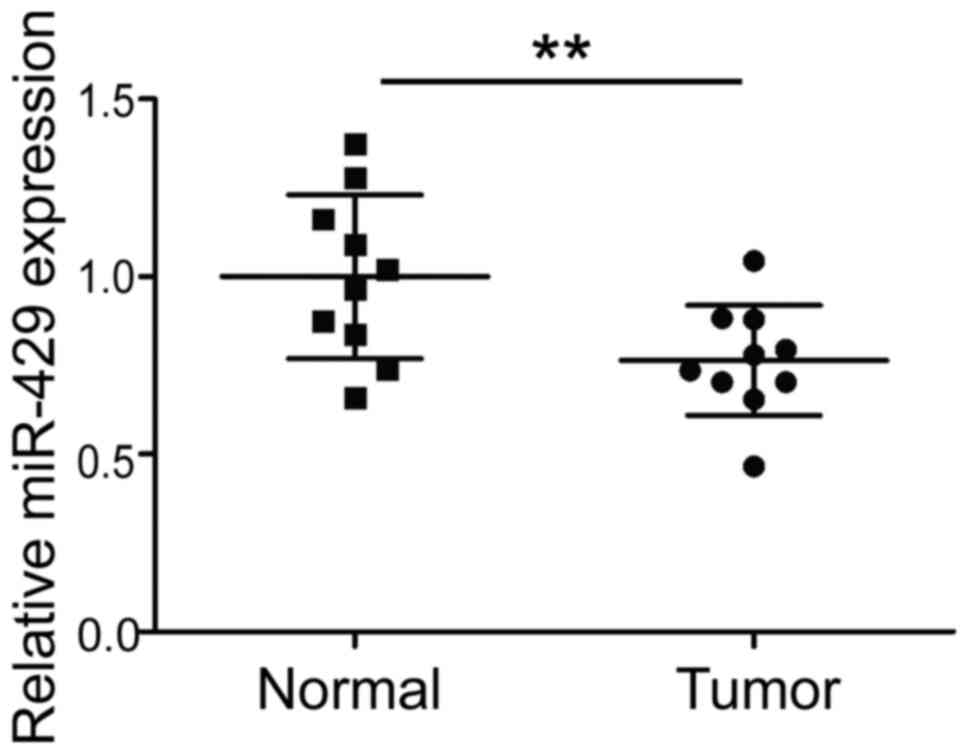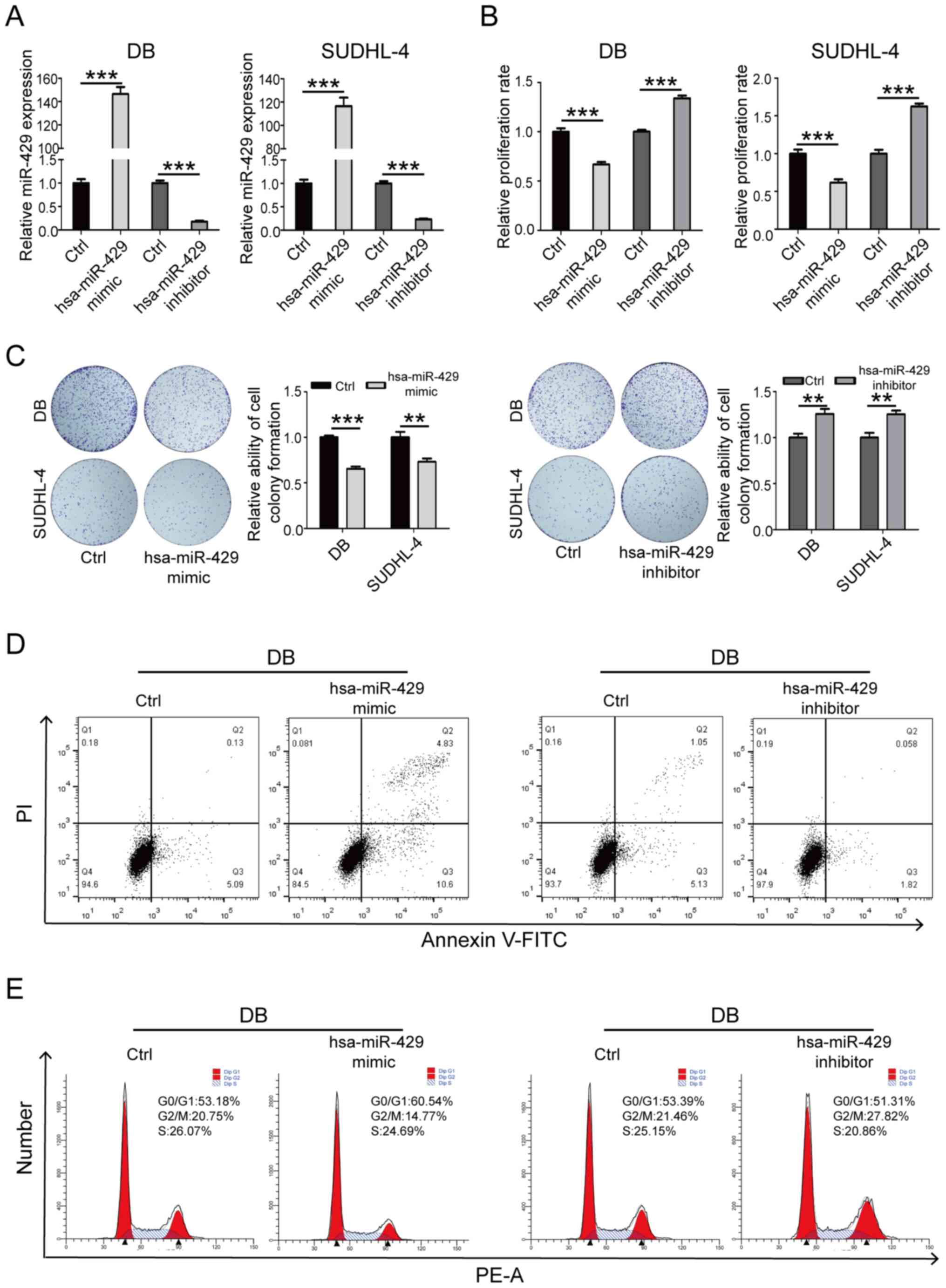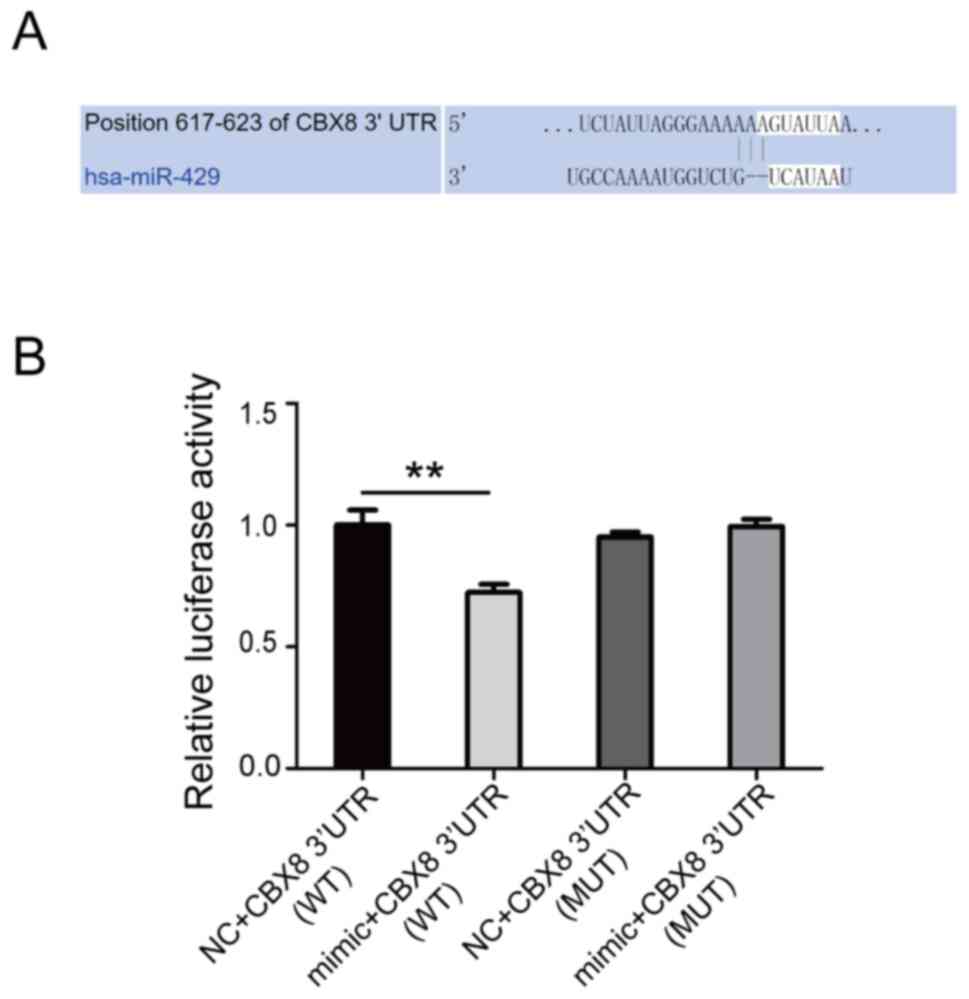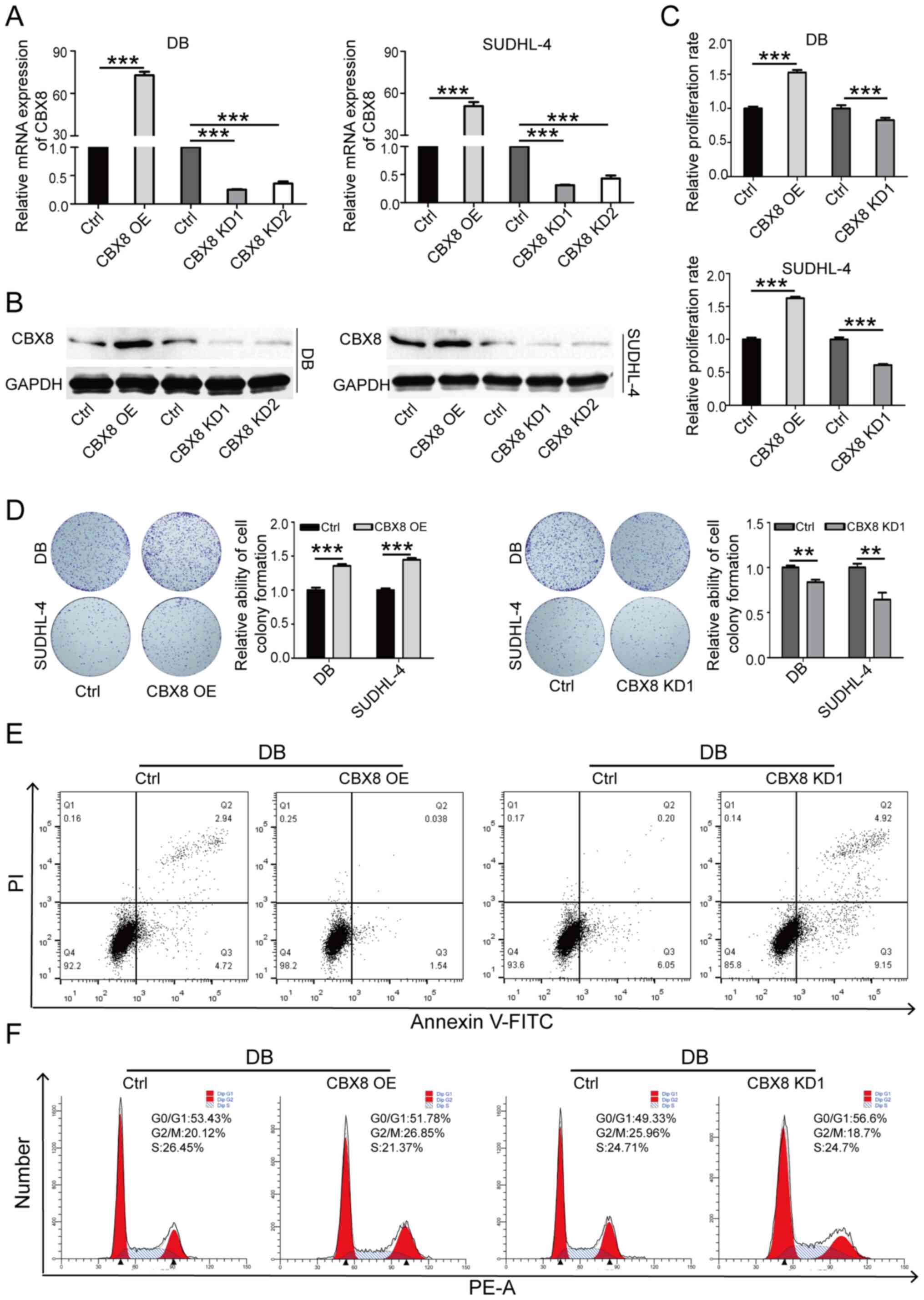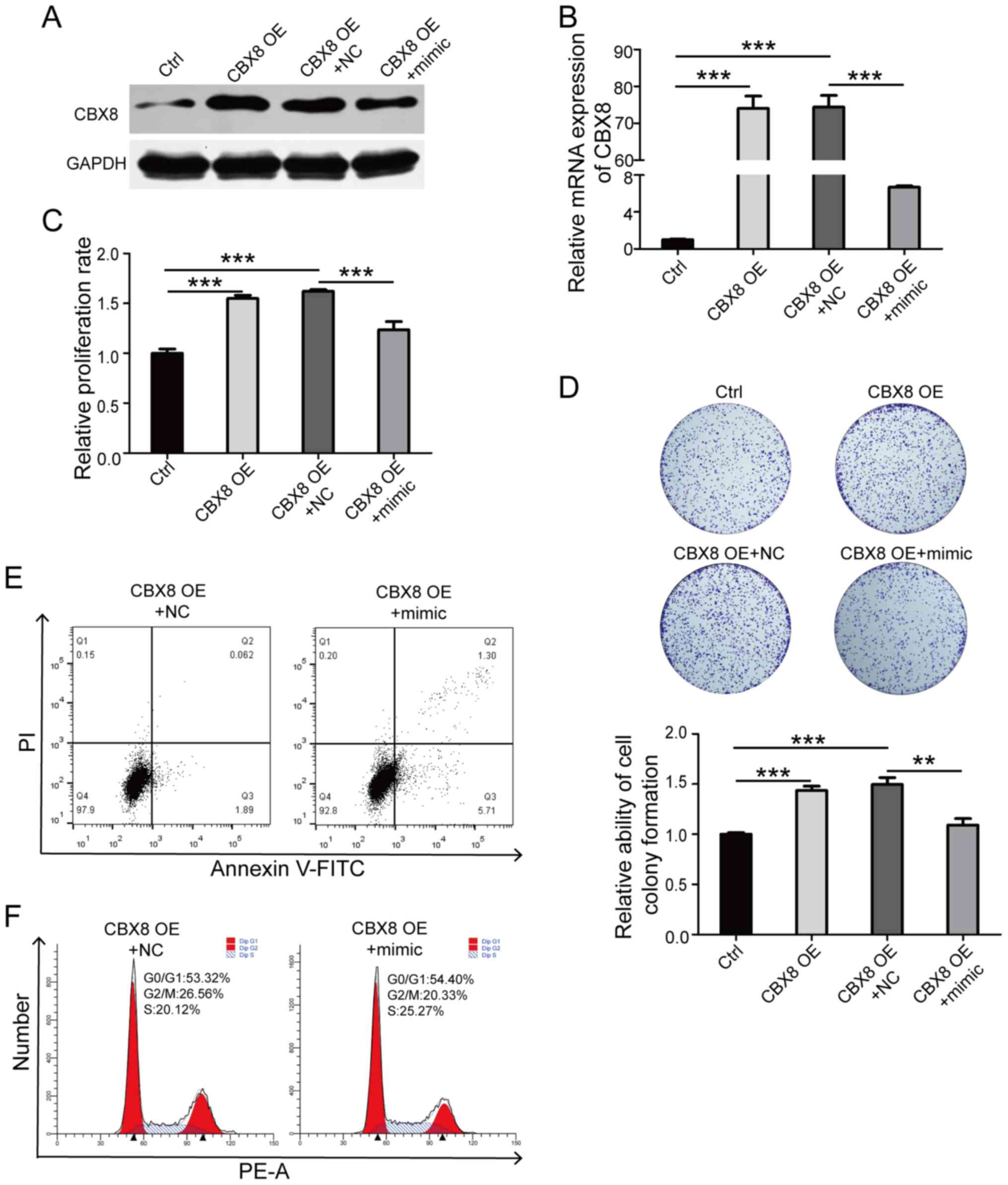|
1
|
Sehn LH and Gascoyne RD: Diffuse large
B-cell lymphoma: Optimizing outcome in the context of clinical and
biologic heterogeneity. Blood. 125:22–32. 2015. View Article : Google Scholar : PubMed/NCBI
|
|
2
|
Sehn LH and Salles G: Diffuse large B-cell
lymphoma. N Engl J Med. 384:842–858. 2021. View Article : Google Scholar : PubMed/NCBI
|
|
3
|
Maltby S, Plank M, Ptaschinski C, Mattes J
and Foster PS: MicroRNA function in mast cell biology: Protocols to
characterize and modulate microRNA expression. Methods Mol Biol.
1220:287–304. 2015. View Article : Google Scholar : PubMed/NCBI
|
|
4
|
Hata A and Lieberman J: Dysregulation of
microRNA biogenesis and gene silencing in cancer. Sci Signal.
8:re32015. View Article : Google Scholar : PubMed/NCBI
|
|
5
|
Cheng CJ, Bahal R, Babar IA, Pincus Z,
Barrera F, Liu C, Svoronos A, Braddock DT, Glazer PM, Engelman DM,
et al: MicroRNA silencing for cancer therapy targeted to the tumour
microenvironment. Nature. 518:107–110. 2015. View Article : Google Scholar : PubMed/NCBI
|
|
6
|
Xue H and Tian GY: miR-429 regulates the
metastasis and EMT of HCC cells through targeting RAB23. Arch
Biochem Biophys. 637:48–55. 2018. View Article : Google Scholar : PubMed/NCBI
|
|
7
|
Guo C, Zhao D, Zhang Q, Liu S and Sun MZ:
miR-429 suppresses tumor migration and invasion by targeting CRKL
in hepatocellular carcinoma via inhibiting Raf/MEK/ERK pathway and
epithelial-mesenchymal transition. Sci Rep. 8:23752018. View Article : Google Scholar : PubMed/NCBI
|
|
8
|
Zhang C, Chang C, Gao H, Wang Q, Zhang F
and Xu C: miR-429 regulates rat liver regeneration and hepatocyte
proliferation by targeting JUN/MYC/BCL2/CCND1 signaling pathway.
Cell Signal. 50:80–89. 2018. View Article : Google Scholar : PubMed/NCBI
|
|
9
|
Zhang M, Dong BB, Lu M, Zheng MJ, Chen H,
Ding JZ, Xu AM and Xu YH: miR-429 functions as a tumor suppressor
by targeting FSCN1 in gastric cancer cells. OncoTargets Ther.
9:1123–1133. 2016.PubMed/NCBI
|
|
10
|
Wu CL, Ho JY, Hung SH and Yu DS: miR-429
expression in bladder cancer and its correlation with tumor
behavior and clinical outcome. Kaohsiung J Med Sci. 34:335–340.
2018. View Article : Google Scholar : PubMed/NCBI
|
|
11
|
Yang J, Liu Y, He A, Liu Y, Wu J, Liao X,
Lv Z, Wang F and Mei H: hsa-miR-429 promotes bladder cancer cell
proliferation via inhibiting CDKN2B. Oncotarget. 8:68721–68729.
2017. View Article : Google Scholar : PubMed/NCBI
|
|
12
|
Deng Y, Luan F, Zeng L, Zhang Y and Ma K:
miR-429 suppresses the progression and metastasis of osteosarcoma
by targeting ZEB1. EXCLI J. 16:618–627. 2017.PubMed/NCBI
|
|
13
|
Wang HF, Wang WH, Zhuang HW and Xu M:
miR-429 regulates the proliferation and apoptosis of nephroblastoma
cells through targeting c-myc. Eur Rev Med Pharmacol Sci.
22:5172–5179. 2018.PubMed/NCBI
|
|
14
|
Liu D, Song L, Dai Z, Guan H, Kang H,
Zhang Y, Yan W, Zhao X and Zhang S: miR-429 suppresses
neurotrophin-3 to alleviate perineural invasion of pancreatic
cancer. Biochem Biophys Res Commun. 505:1077–1083. 2018. View Article : Google Scholar : PubMed/NCBI
|
|
15
|
Zong M, Liu Y, Zhang K, J Y and Chen L:
The effects of miR-429 on cell migration and invasion by targeting
Slug in esophageal squamous cell carcinoma. Pathol Res Pract.
215:1525262019. View Article : Google Scholar : PubMed/NCBI
|
|
16
|
Wang Y, Liu J, Yao Q, Wang Y, Liu Z and
Zhang L: LncRNA SNHG6 promotes Wilms' tumor progression through
regulating miR-429/FRS2 axis. Cancer Biother Radiopharm. Jan
22–2021.(Epub ahead of print). View Article : Google Scholar
|
|
17
|
Zhang L, Liu Q, Mu Q, Zhou D, Li H, Zhang
B and Yin C: miR-429 suppresses proliferation and invasion of
breast cancer via inhibiting the Wnt/β-catenin signaling pathway.
Thorac Cancer. 11:3126–3138. 2020. View Article : Google Scholar : PubMed/NCBI
|
|
18
|
Cava C, Novello C, Martelli C, Lodico A,
Ottobrini L, Piccotti F, Truffi M, Corsi F, Bertoli G and
Castiglioni I: Theranostic application of miR-429 in
HER2+ breast cancer. Theranostics. 10:50–61. 2020.
View Article : Google Scholar : PubMed/NCBI
|
|
19
|
Livak KJ and Schmittgen TD: Analysis of
relative gene expression data using real-time quantitative PCR and
the 2(-Delta Delta C(T)) Method. Methods. 25:402–408. 2001.
View Article : Google Scholar : PubMed/NCBI
|
|
20
|
Zhang CZ, Chen SL, Wang CH, He YF, Yang X,
Xie D and Yun JP: CBX8 exhibits oncogenic activity via
AKT/β-catenin activation in hepatocellular carcinoma. Cancer Res.
78:51–63. 2018. View Article : Google Scholar : PubMed/NCBI
|
|
21
|
Tang B, Tian Y, Liao Y, Li Z, Yu S, Su H,
Zhong F, Yuan G, Wang Y, Yu H, et al: CBX8 exhibits oncogenic
properties and serves as a prognostic factor in hepatocellular
carcinoma. Cell Death Dis. 10:522019. View Article : Google Scholar : PubMed/NCBI
|
|
22
|
Xiao L, Zhou Z, Li W, Peng J, Sun Q, Zhu
H, Song Y, Hou JL, Sun J, Cao HC, et al: Chromobox homolog 8 (CBX8)
Interacts with Y-Box binding protein 1 (YBX1) to promote cellular
proliferation in hepatocellular carcinoma cells. Aging (Albany NY).
11:7123–7149. 2019. View Article : Google Scholar : PubMed/NCBI
|
|
23
|
Zhang Y, Chen H, Zhu H and Sun X: CBX8
promotes tumorigenesis and confers radioresistance in esophageal
squamous cell carcinoma cells through targeting APAF1. Gene.
711:1439492019. View Article : Google Scholar : PubMed/NCBI
|
|
24
|
Xiao W, Ou C, Qin J, Xing F, Sun Y, Li Z
and Qiu J: CBX8, a novel DNA repair protein, promotes tumorigenesis
in human esophageal carcinoma. Int J Clin Exp Pathol. 7:4817–4826.
2014.PubMed/NCBI
|
|
25
|
Tang J, Wang G, Zhang M, Li FY, Sang Y,
Wang B, Hu K, Wu Y, Luo R, Liao D, et al: Paradoxical role of CBX8
in proliferation and metastasis of colorectal cancer. Oncotarget.
5:10778–10790. 2014. View Article : Google Scholar : PubMed/NCBI
|
|
26
|
Lee SH, Um SJ and Kim EJ: CBX8 suppresses
Sirtinol-induced premature senescence in human breast cancer cells
via cooperation with SIRT1. Cancer Lett. 335:397–403. 2013.
View Article : Google Scholar : PubMed/NCBI
|
|
27
|
Lee SH, Um SJ and Kim EJ: CBX8 antagonizes
the effect of Sirtinol on premature senescence through the
AKT-RB-E2F1 pathway in K562 leukemia cells. Biochem Biophys Res
Commun. 469:884–890. 2016. View Article : Google Scholar : PubMed/NCBI
|
|
28
|
Zeng F, Luo L, Li D, Guo J and Guo M:
KPNA2 interaction with CBX8 contributes to the development and
progression of bladder cancer by mediating the PRDM1/c-FOS pathway.
J Transl Med. 19:1122021. View Article : Google Scholar : PubMed/NCBI
|
|
29
|
Wang S, Tailor K and Kwabi-Addo B:
Androgen-induced epigenetic profiles of polycomb and trithorax
genes in prostate cancer cells. Anticancer Res. 40:2559–2565. 2020.
View Article : Google Scholar : PubMed/NCBI
|















